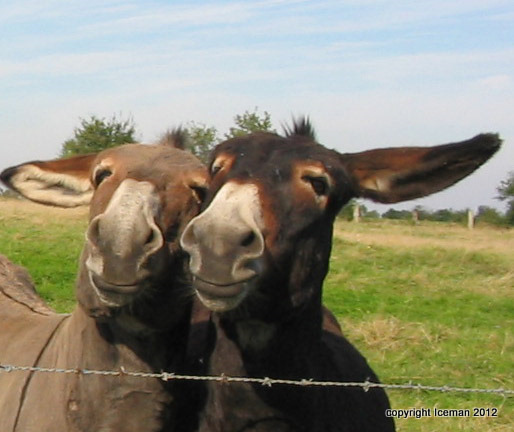Archive for the ‘Trust’ Category
To make a difference, believe in yourself.
 When the mainstream products become tired, there’s incentive to replace it, but while sales are good there’s no compelling reason to obsolete your best work. Things that matter start from things that no longer matter.
When the mainstream products become tired, there’s incentive to replace it, but while sales are good there’s no compelling reason to obsolete your best work. Things that matter start from things that no longer matter.
The gestation period for a novel idea to transition to viable technology then to a winning product and the processes to bring it market is longer than anyone wants to admit. If you haven’t done it before it takes twice as long as you think and three times longer than you want. If you stomp on the accelerator once there’s consensus you should, you waited too long.
There’s a simple way to tell it’s time to accelerate. When the status quo sets the cruise control to “coast”, it’s time. When new there’s no time to work on new concepts, that’s coasting. When ROI analyses are required for most everything, that’s coasting. When forward-looking work is cut and cost reduction work is accelerated, that’s a sure sign of coasting.
As soon as you recognize coasting, it’s time to circle the wagons and create an acceleration plan. It’s not across-the-board acceleration, nor is it founded on people working harder or taking on more projects. The plan starts with a business objective and a commitment to add resources to speed things up. If the plan isn’t tied tightly to an important business objective it will miss the mark, and if incremental resources are not applied to the work, it won’t accelerate.
Here’s a rule – if projects and resources don’t change, you haven’t changed anything.
When you can feel the low pressure system in your body and can smell the storm brewing over the horizon, you have an obligation to do something about it. But moving resources and starting projects at the expense of stopping others is emotionally charged work, and the successful organization will reject these changes at every turn. And everyone will think there’s no need to change, but they’ll be wrong.
It’s will be tough going, but your instincts are good and intuition is on-the-mark – there is a storm brewing over the horizon. Push through the discomfort, push through the fear, push through the self-doubt.
It’s time to believe in yourself. It’s the only thing powerful enough to make a difference.
Image credit – Chris Kim
Scarcity and Abundance
 Supply and demand have been joined at the hip since the beginning. When demand is high, the deck is shuffled so supply seems low. The fabricated scarcity drives up prices and shareholders are happy. When demand is low, the competition pushes each other on price. The abundance creates a commodity, and it’s a race to the bottom.
Supply and demand have been joined at the hip since the beginning. When demand is high, the deck is shuffled so supply seems low. The fabricated scarcity drives up prices and shareholders are happy. When demand is low, the competition pushes each other on price. The abundance creates a commodity, and it’s a race to the bottom.
But this is old thinking.
Scarcity isn’t a lever to jack up prices or manipulate relationships, it’s an opportunity to spend your limited resources on the most important work and to build relationships. When you tell a potential partner you want work with them and you are willing to spend your finite resources to make it happen, it’s a huge compliment. Voting with your feet makes a powerful statement that you’re serious about working with them because you think they’re special. You are telling them that you will say no to others so you can say yes to them. Both know they’re part of something important and the free-flowing positivity results in something otherwise impossible.
Scarcity is limiting only if your mental framework thinks it is. If you hoard and hold tightly, scarcity breeds win-lose relationships governed by power dynamics. But if you choose the anti-framework, scarcity creates trust.
Played differently, abundance does not create commodity, it’s opportunity to show others you have enough to spare. In personal relationships, when you share some of your work for free your relationships blossom. When you give it away you are signaling that you have plenty to spare. It’s clear to everyone you are a geyser of new thinking. Here – take this. I’ll make more. These simple words create a foundation of trust which bolsters your personal brand. And because all business relationships are personal relationships, it does the same thing for your company’s brand.
Make it a commodity or give it away – how you see abundance is your choice. The old way breeds bare-knuckled competition. The new way creates a brand steeped in trust.
If you have scarcity, be thankful for it. Allocate your precious resources thoughtfully and with love. Spend your time with the people and causes that matter. It will feel good to everyone, including you. And if you have abundance, be thankful. Choose to develop closer relationships based on trust. Choose to give it away.
Happy Thanksgiving.
image credit — GloriaGarcia
The Special People That Believe in You
 Companies don’t need more ideas, they need ideas that are more meaningful. Companies have plenty ideas because they measure and track the number of new ideas generated. Enter your idea on the company’s open innovation web portal, and you’re done. Let the record show that a new idea was added to the hopper. Increment the counter and update the metrics. One new idea for the good guys. It’s a good day to be alive.
Companies don’t need more ideas, they need ideas that are more meaningful. Companies have plenty ideas because they measure and track the number of new ideas generated. Enter your idea on the company’s open innovation web portal, and you’re done. Let the record show that a new idea was added to the hopper. Increment the counter and update the metrics. One new idea for the good guys. It’s a good day to be alive.
For some reason leaders are comforted by a large number of new ideas in the hopper even though there’s no hope of working on them. Maybe they think there’s value in a backlog of ideas they can fall back on if the existing work doesn’t pan out. If that’s the case, they probably think the ideas in the hopper have good potential. But because the ideas are not graded on their potential, that’s simply wishful thinking.
The only thing good about counting the number of new ideas is that the number of new ideas is easy to count. The good thing about grading ideas on their level of meaningfulness is it causes the most meaningful ideas to rise to the top. The bad thing about grading ideas is that it requires judgement. And today, judgment is in short supply. If you use your judgement poorly your career suffers, but if you avoid using your judgement no one notices. Here’s a rule: If you never you use your judgement, you can never use it poorly.
For a select few, any work that doesn’t require judgment doesn’t rise to the level of work worth doing. For them, only the most meaningful work will do, and rolling the dice on their career is simply the cost of doing business. For them, it’s judgement or bust.
If you use your judgement and choose to work on a meaningful idea, be prepared for the loneliness. Meaningful ideas are, by definition, understood by a few and misunderstood by the rest. It’s lonely to advance an idea that most don’t understand. And prepare to be misjudged for your actions because your steadfast pursuit of the idea will also be misunderstood. Your vigor and aliveness will be seen as aggressiveness, anger, negativity, closemindedness, or political incorrectness. But this misjudgment comes with the territory. There’s no way around it. It’s just how it goes. It’s not personal.
But just as the trivial many will try to tear you down, there are a vital few who will praise you, support you and bolster you. These are the special people in your organization. You know who I’m talking about. You have a personal relationship with them. You know about their families. You’ve been through tough times together. They’ve seen you struggle, stumble and tumble, and they’ve seen you get up and move forward. They’ve seen you run into a brick wall and helped you back to your feet. Don’t dismiss their praise and don’t feel guilty about accepting help from them. They don’t want credit for helping you, they want you to succeed.
You don’t know this, but those special people want to help you because you’ve already helped them. Some time ago you unknowingly helped them through a tough time, or were kind to them. Or, you invested in them or believed in them. More than likely, though, you inspired them.
Keep moving forward. Keep pushing. And take comfort from the special people that believe in you.
Image credit – Ice Man
Ideas That Threaten
 Every idea that’s worth its salt will be rejected out of hand. That’s just how it is. You can get angry because you didn’t get the support you think you deserve or you can accept the fact that their negative reaction is about them. The first way you shut down and your idea dies on the vine. The second way you let their negativity pass right through you and continue your uphill slog until your idea is commercialized. Either way, it’s your choice.
Every idea that’s worth its salt will be rejected out of hand. That’s just how it is. You can get angry because you didn’t get the support you think you deserve or you can accept the fact that their negative reaction is about them. The first way you shut down and your idea dies on the vine. The second way you let their negativity pass right through you and continue your uphill slog until your idea is commercialized. Either way, it’s your choice.
It’s difficult to let others’ negativity pass though you. It may be easier to flip the situation on its head.
When confronted with an exceptional idea, people generate a negative response. The underlying feeling is fear, but usually manifests as aggressive dismissal. Instead of reacting with anger, maybe you can learn to see their fear-based reaction as a signifier of significance. When you have a tooth with a cavity and you drink cold water, your tooth creates a reactionary zing of electrical energy, a tell-tale sign of the underlying decay. The zing signifies the significance. Just as the cold water elicits an electrical response from the cavity, the exceptional idea elicits a negative response from the person. Don’t worry about the negative response, revel in it.
The only thing better than an idea that is so good it threatens is an idea that’s so good no one can understand. These ideas are so deep, no novel, so twisted they conflict with conventional wisdom. These ideas confuse everyone, especially the experts. At first the experts aren’t threatened because they don’t yet understand. They chuckle and take pity on you for thinking such strange thoughts. Just as a negative reaction indicates significance, their chuckles and pity are leading indicators of significance. Don’t let their reactions deter you, let them inspire you. As your unconventional wisdom seeps into them and they begin to understand, their chuckles will morph into aggressive dismissal. This tell-tale sign makes it clear you’re on to something.
If your idea doesn’t get a negative reaction, you’re not trying hard enough. Think bigger. If your idea doesn’t threaten your most profitable product, come up with one that does. If your idea doesn’t shake the fillings out of your business model, go away and don’t come back to you have one that does.
Companies don’t need more ideas, they need ideas that are more creative. They don’t need more continuous improvement, they need more discontinuous improvement. And they don’t need ideas that build on success, they need ideas that dismantle it.
If your ideas don’t threaten, don’t bother.
Image credit — Ed Schipul
The cards don’t matter. What matters is how you play them.
 What you think of yourself colors everything you do. When someone challenges your ideas, your response makes it clear how you see yourself. Regardless of your response, you tip your hand. Regardless of your response, everyone can see your cards.
What you think of yourself colors everything you do. When someone challenges your ideas, your response makes it clear how you see yourself. Regardless of your response, you tip your hand. Regardless of your response, everyone can see your cards.
When you have a terrible poker hand like, say, a king high, you can respond three ways. You can fold and let the challenger go unchallenged. You can check and kick the can down the road. Or you can bluff and go toe-to-toe with the challenger. With the fold you see things as they are and behave accordingly. The fold is an admission you have a lesser hand. And sometimes that’s difficult to do. The check says you don’t want others to know you have a terrible hand but you thing things will turn around. With the bluff you pretend things are different than they are and you pretend accordingly. You may fool the unseasoned player on your right, but make no mistake, the card shark on your left knows you’re bluffing. And deep down, you know too.
With a middle-of-the-road hand like the full house you have the same options. The fold is less likely because your hand is stronger. You fold only when you sense a strong challenge and the pot is large. No sense going head-to-head with a player with swagger when the stakes are high. There’s no harm in folding. The check says you’re not sure of yourself, or, you are and your hand is neither special nor terrible. The bluff is still risky but less so. If you think you can survive getting caught and are okay with the follow-on judgement, there’s a larger probability you’ll try.
With four aces you call the shots. The fold is reserved for those special situations where you want to preserve the status of players you care about. Or, when you have enough chips and you want others to get the glory. Either way it’s too little used. Few have the self-worth, generosity and thoughtfulness to play things that way. The check is equally generous. The check says you’re comfortable with your cards and how the hand is going. No need to flex your muscles. When you have the winning cards the bluff is counterproductive. Playing bigger than your hand pushes everyone away and they fold. You may with the pot, but next hand they’ll go after you. Embarrassing the other players is no way to play.
Really, though, your cards don’t matter. Regardless of your cards, don’t take a challenge personally. Regardless of your cards, respond like you hold all of them – all the aces, face cards, and all the wild cards.
It relatively easy to behave this way when the professional challenges your ideas because they don’t challenge you, they challenge your ideas. And you are not your ideas. Look deeply and honestly at the ideas and leave your self out of it. But it’s more difficult with the hack. Under the banner of challenging your ideas, the hack will try to challenge you. Here’s where you’ve got to hold onto a fundamental truth – no one can challenge you without your consent. Here’s where you’ve got to remember this truth applies to everyone – those with a four-of-a-kind, those with a full house, and those with a pair of twos. Here’s where you’ve got to remember that your cards don’t matter. The best way I know how to do that is to visualize your self as a screen door and let their hot air pass through you.
The challenges don’t matter and neither does the hand you were dealt. All that matters is your response. Respond with your heart’s best intentions and everyone will split the pot and they’ll want you to deal every hand.
Image credit – lawrence
Accountability is not the answer.
 People have a natural bias toward doing what was done last time. The behavior is the result of untold generations that evolved to serve a single objective – to survive. Survival is about holding onto what is – protecting the family, providing food and waking up the next morning. In survival mode any energy spent on activities even partially unrelated to food, water and shelter is wasted energy. Any deviation from the worn path creates newness and uncertainty which causes adrenaline to flow and increases caloric burn rate. In survival mode the opportunity cost of those extra calories is larger than the potential benefit of a new experience.
People have a natural bias toward doing what was done last time. The behavior is the result of untold generations that evolved to serve a single objective – to survive. Survival is about holding onto what is – protecting the family, providing food and waking up the next morning. In survival mode any energy spent on activities even partially unrelated to food, water and shelter is wasted energy. Any deviation from the worn path creates newness and uncertainty which causes adrenaline to flow and increases caloric burn rate. In survival mode the opportunity cost of those extra calories is larger than the potential benefit of a new experience.
Today, calories are readily available for most and survival is no longer the objective, yet the bias persists. Today, the bias is not driven by a culture of survivability. It’s driven by a culture of accountability. Accountability forces its own singular focus – make the numbers – and, like survivability, tightly links the consequences of mistakes and shortcomings to the individual. Spend your calories any way you want just don’t miss the numbers.
In a culture of accountability there is no time to rest and recharge. Like the predator that never sleeps, metrics continually keep a hungry eye on the human prey. And like with food and water, any deviation from the worn path of increased throughput and profit is unsafe behavior.
But when the watering hole dries up and the fruit has been picked from the trees, the worn path isn’t the safest path. Frantic foraging is the only real option, but it’s not much safer and certainly no way to go through life. Paradoxically, a culture of accountability, with its intent of reducing the risk of missing the numbers can create far more dangerous failure modes. Where over fishing depletes the fish population and over farming makes for a dust bowl, over reliance on what worked last time can create failure modes that jeopardize survival.
To break the bias and help people do new things, measure new things and talk about new things. Start the next meeting with a review of what’s different. The team will feel energized. And after the discussion, adjourn the meeting because everything else is the same. At the next status meeting, talk only about the surprising insights. With the next email, send praise about the new learning. At team meetings, acknowledge the inherent uncertainty of doing new things and praise it over the potentially catastrophic consequences of over extending the tried-and-true. And for metrics, stop measuring outcomes.
Image credit — Applied Nomadology
There is no control. There is only trust.
 Control strategies don’t work, but trust strategies do.
Control strategies don’t work, but trust strategies do.
Nothing goes as planned. Trying to control things tightly is wasteful. It takes too much energy to batten down all the hatches and keep them that way every-day-all-day. Maybe no water gets in, but the crew doesn’t get enough oxygen and their brains wither.
Trust on the other hand, is flexible and far more efficient. It takes little energy to hire a pro, give them the right task and get out of the way. And with the best pros it requires even less energy because the three-step becomes a two-step – hire them and get out of the way.
When both hands are continuously busy pulling the levers of contingency plans there are no hands left to point toward the future. When both arms are clinging onto the artificial schedule of the project plan there are no arms left to conduct the orchestra. Control strategies make sure even the piccolo plays the right notes at the right time, while trust strategies let the violins adjust based on their ear and intuition and even let the conductors write their own sheet music.
Control is an illusion, but trust is real. The best statistical analyses are rearward-looking and provide no control in a changing environment. (You can’t drive a car by looking in the rear view mirror.) Yet, that’s the state-of-the-art for control strategies – don’t change the inputs, don’t change the process and we’ll get what we got last time. That’s not control. That’s self-limiting.
Trust is real because people and their relationships are real. Trust is a contract between people where one side expects hard work and good judgment and the other side expects to be challenged and to be given the flexibility to do the work as they see fit. Trust-based systems are far more adaptable than if-then control strategies. No control algorithm can effectively handle unanticipated changes in input conditions or unplanned drift in decision criteria, but people and their judgement can. In fact, that’s what people are good at, and they enjoy doing it. And that’s a great recipe for an engaged work force.
Control strategies are popular because they help us believe we have control. And they’re ineffective for the same reason. Trust strategies are not popular because they acknowledge we have no real control and rely on judgment. And that’s why they’re effective.
When control strategies fail, trust strategies are implemented to save the day. When the wheels fall off a project, the best pro in the company is brought in to fix what’s broken. And the best pro is the most trusted pro. And their charge – Tell us what’s wrong (Use your judgement.), tell us how you’re going to fix it (Use your best judgement for that.) and tell us what you need to fix it. (And use your best judgement for that, too.)
In the end, trust trumps control. But only after all other possibilities are exhausted.
Image credit – Dobi.
 Mike Shipulski
Mike Shipulski